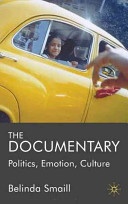| Belinda Smaill, The Documentary: Politics, Emotion, Culture London: Palgrave Macmillan, 2010. ISBN: 9780230237513 US$80.00 (hb) 221pp (Review copy supplied by Palgrave Macmillan) |
 |
One of the strengths of Belinda Smaill’s book is the range of documentaries it discusses: pornography documentaries; a focus on the work of Kim Longinotto; Asian Australian documentaries; and the 2008 season of the Australian Idol television program. Smaill engages with these works thoughtfully and respectfully.
Smaill begins the introduction by referencing Bill Nichols’ term the “discourses of sobriety”, and she returns to this term throughout the book – rightly so in a book which takes as its project the consideration of emotion in the documentary genre. Smaill explains:
This is an investigation into how individuals are positioned by documentary representation as subjects that are entrenched in the emotions, whether it is pleasure, hope, pain, empathy or disgust. The individuals I am referring to are, in some instances, film-makers, and in others, those who are featured in the documentary. By ‘entrenched’ I mean not simply that the poetics of the film, such as music, rhetoric or narrative, frame individuals in ways that elicit emotional responses from viewers, but that emotion confers cultural meanings onto others. (3)
It was important that Smaill frame her work and approach early on, in order to address the obvious questions: whose emotions are being considered? The subject? The audience? The film-maker? Emotions are of course not amenable to quantifiable analysis; and, I would add, resist or perhaps exceed qualitative analysis and interpretation as well. Smaill set herself a difficult and important problem; one well worth addressing. If one limits oneself to a discourse of sobriety, what does that exclude?
Bill Nichols’ term referred to documentaries themselves, but scholarly work itself may also be seen as a discourse of sobriety. When we write about film, do we feel constrained to write as if we are affectless beings?
Throughout the book Smaill perhaps takes the only route she can; which is to largely gloss over the question of whose emotions are under discussion, with the discussion operating on an abstract level. Smaill states upfront that she will not address reception in the book: this is fair enough, given that reception does not correlate tidily with emotion. However, paying more – concrete? speculative? – attention to the physical, emotional beings who watch documentaries would have strengthened the book.
Smaill largely focuses on the works, not the filmmakers. In the chapter which discusses Born into brothels (USA 2004), she does note the contrast between the child subjects’ immobility and the film-maker Zana Briski’s mobility and privilege (156). Zana Briski is one of the most visible film-makers in any of the documentaries discussed; on screen for a large proportion of time and voicing a narration ‘owning’ the film. The film-makers/subjects in the chapter “Loss and Care: Asian Australian Documentary”, fall into a different category given the performative elements shaping Chinese Takeaway (Australia 2002), Sadness: A Monologue by William Yang (Australia 1999) and The Finished People (Australia 2003).
The chapter “Pleasure and Disgust: Desire and the Female Porn Star” is thought-provoking. Pornography is clearly a performance. What is a pornography documentary? A discourse of sobriety, “seek[ing] to inform and educate the viewer about the sensational or the problematic and exploitative nature of the industry” (32), or a discourse of legitimised prurience? Smaill (40) rightly points out the ambivalence of the pornography performance. Is Annabel Chong experiencing pain, pleasure, both, neither? (Sex: The Annabel Chong Story [US 1999]) This highlights, I argue, one of the reasons for our interest in documentary. When watching documentaries we are all anthropologists, trying to make sense of each other and the things we do, with the added bonus that we can gaze unabashed and uninterrupted more easily than we may do in life.
That’s certainly one of the reasons why I watch reality television; to try to understand, predict or deconstruct the gap between what someone says and how someone thinks and feels. Smaill’s discussion of Australian Idol is an odd choice for the book; all the other works are self-contained entities, whereas the chapter “Nostalgia, Historical Time and Reality Television: The Idol series” considers one season of a long-running show which has not been on air since 2009. The chapter is somewhat hermetic: speculating on the reasons for the show’s success while not acknowledging that the season under analysis was actually its penultimate year. The show’s clear focus on performance may explain Smaill’s interest, given her other choices in the book.
It is impossible now to think of Nichols’ discourse of sobriety without also thinking of Michael Renov’s discourse of delirium:
…a continuum of motives underlying documentary reception ranging from what I would call historiographical curiosity (motivated by our manifest appetite to know the look and feel of a past preserved for our view) to a more freely associative fascination with the image along the lines of Barthes’s notion of punctum, the explosive prick of contact with one’s own image repertoire evoked by the documentary image. (Michael Renov, The Subject of Documentary [Minneapolis, 2004], 100-101)
I think it is not a question of having to choose a discourse of sobriety or a discourse of delirium – and Smaill does not suggest we must. Rather, just as we may be struggling to integrate and value correctly both thought and emotions in our daily lives, so we may struggle with this in our critical work.
In The Documentary: Politics, Emotion, Culture, Smaill has not entirely or wholly satisfactorily answered the questions she posed, but has contributed to a conversation that she and others can take up in other work in the future.
